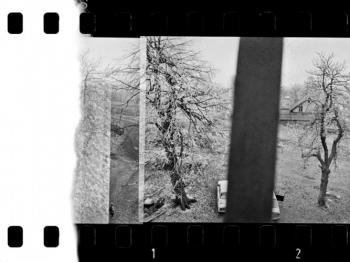The exhibition held at Gallery Školská 28 and in the project space Grey Room presents a selection from the work of three distinguished figures of the generation of Czech photographers whose artwork was shaped during the 80s. The frame of reference used by the curator, Tomáš Pospěch, is the term of visualism, which was coined in the 1980 by the media artist and theorist Andreas Müller-Pohle. It remains a question as to whether or not such tendencies can be defined as visualism in the Czech context, or rather seen as a response to the impulses of subjective documentary, or as a reflection of the program of elementary photography, as was much discussed in Poland at that time. In any case, during the 80s, visualism was a major influence, with dozens of European photographers claiming allegiance to the trend. In recent years, the photographs of Josef Moucha, Karel Kameník and Bořek Sousedík have been exhibited only rarely in Prague. The exhibition thus offers a unique opportunity to see these images in the broader context of a retrospective of the 80s photography.
In the Czech context, the authors connected to visualism were the ones rejecting the traditional, mostly socially formulated document, for a more subjective authors statement. For them, photography was not a reproduction of objects anymore, and interpretation of socially expressed content, but was becoming “an experience of seeing” connected with searching for an autonomous photographic expression. Such photography is not absorbed by what denotes, because it refers most importantly on itself. Therefore visualism is among others also visual contemplation on photography, a metalanguage.
Tomáš Pospěch
The 80's was a time of slow change of the social and cultural climate. The art scene was divided into the official scene, accepted by the authorities, and community lot semiofficial, rather private, forced to oppose the bureaucratic, cultural and political pressure of the establishment. Both scenes coexisted next to each other, and by their merging, rather wide "grey zone" emerged, which enabled the existence to all the artists. Under the surface of so called official art, the scene was alive with its extensive and wide array of activities. The artists, ignored by the establishment and union institutions, had created their own subculture, which had replaced the traditional criticism, media, and art spaces, and enabled the immensely important art confrontation meetings. The art ordained to seclusion was paradoxically in closer contact with many viewers. The shows located in alternative spaces fought with misunderstanding, despise and bullying from the bureau side, but were freer than the official exhibitions and often they drew more attention of a wider audience.
The photographic documentation has a historic and documentary value, and at the same time it captures the happening itself. Often it is the only proof which remains after short-term projects. It captures atmosphere of the period, the need to showcase, the first showcase of the young artists, comparison with the works of the older colleagues, method of installation, the endeavour to engage into public life, the search for new forms of expression and free space.
PHOTOGRAPHY AS PHOTOGRAPHY
Searching for visualism on the example of works by Karel Kameník, Josef Moucha and Bořek Sousedík
Participating authors: Karel Kameník, Josef Moucha, Bořek Sousedík. Curated by Tomáš Pospěch.
Special thanks to FOTOFORUM for techical support.
In the occassion of the exhibition is a lecture of Tomáš Pospěch, Monday October 10 at 6.30 pm












